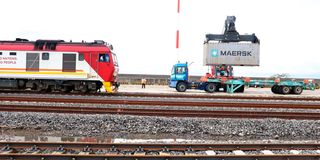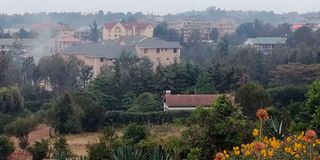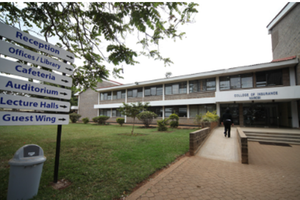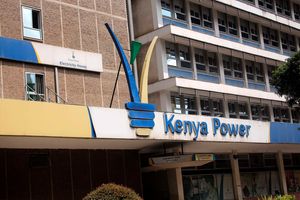
The Naivasha Standard Gauge Railway (SGR) and Metre Gauge Railway (MGR) link at the Naivasha Inland Container Depot (ICD).
A court has dismissed a petition seeking to stop the construction of the Sh8.7 billion Riruta-Ngong metre-gauge railway line over claims that the government failed to conduct public participation before commencing the project.
Justice Anne Omollo ruled that Kenya Railways Corporation, together with the Ministry of Roads and Transport and Chinese contractors, conducted adequate public engagement before the project's rollout.
She found that stakeholder consultations were held prior to the preparation and submission of the Environmental and Social Impact Assessment report to the national environmental regulator.
The petition had been filed by the Karen Lang’ata District Association, which claimed that the public participation process was inadequate and excluded directly affected persons.

A section of Ngong town. The Sh8.7 billion Riruta-Ngong metre-gauge railway will pass the town.
“Taking all the evidence into account, I find that the respondents conducted adequate public participation before the assessment report dated May 17, 2024, was prepared and submitted to the National Environment Management Authority (Nema). Therefore, the Environmental Impact Assessment license cannot be declared null and void due to lack of public participation,” said Justice Omollo.
The 12.5-kilometre proposed commuter railway, which links Riruta, Karen, Bulbul and Ngong in Nairobi and Kajiado counties, was launched in December 2023 to help ease traffic congestion and improve public transportation.
Once completed, the project is expected to serve 10,000 passengers daily.
On concerns raised by the petitioners about possible adverse environmental effects, the judge noted that these were not sufficient grounds to stop the project. She said that the railway line is intended to benefit the wider public and serves a greater public good.
No prove of threat
“There is a need to balance, on one hand, the protection of the right to a clean and healthy environment, and on the other, the protection of public interest—in this case, infrastructure development to reduce transport congestion. The petitioner has not proved any actual or threatened harm to warrant the court’s intervention,” the judge said.
She added that environmental concerns can be addressed through ongoing monitoring and corrective actions, including improvement and restoration orders.
The petitioners claimed the project began on government land allocated to the Directorate of Veterinary Services in Ngong without proper public consultation or environmental assessment.
They stated that a stakeholders’ meeting was held on April 12, 2024, at St Christopher’s International School in Karen, where Kenya Railways introduced the project. During the meeting, the petitioners alleged there was an admission that no EIA had been conducted. They raised concerns about air, noise, and water pollution, as well as broader environmental impacts, including threats to local biodiversity.
According to the petitioners, the Karen area contains ecologically sensitive forest land and residential zones with significant tree cover, which they feared the project could harm. They also claimed that the government failed to consider alternative, less destructive routes, violating constitutional and environmental safeguards.
Additionally, the petitioners argued that there had been no public involvement in the planning or budgeting of the project, which they claimed violated constitutional principles of public finance transparency. They described the railway as wasteful and risky to both public funds and the environment, and said the government ignored their proposed alternatives.
They also questioned the authenticity of public participation questionnaires, some of which were undated or unsigned.
In the petition, they sought to quash the contract between Kenya Railways Corporation, China Railway Design Corporation, and Apec Consortium Co Ltd, and to declare the project unlawful and unconstitutional. They also asked the court to issue a permanent injunction halting the project until public participation and legal requirements were met.

A gavel.
However, Justice Omollo declined to grant the orders, finding that the project's public utility justified its continuation and that the ESIA report included measures to mitigate environmental harm.
“I decline to issue an order quashing or revoking any decision of the respondents related to construction or ongoing work on the project,” she ruled.
Regarding the claim that the project violated the petitioners' right to a clean and healthy environment, the court found that the report clearly outlined the responsibilities of Kenya Railways and the contractor in ensuring environmental protection during implementation.
“The petitioner, upon receiving the assessment report either from Nema or in the Kenya Railways Corporation's response—was required to explain why the mitigation measures outlined were insufficient. Instead, they focused only on the alleged lack of public participation,” said the judge.
The court also noted the government’s assurance that the project would cause minimal disruption to private property and residents.







